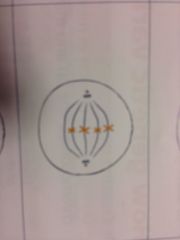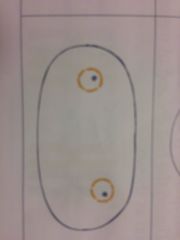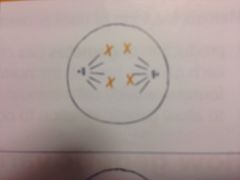![]()
![]()
![]()
Use LEFT and RIGHT arrow keys to navigate between flashcards;
Use UP and DOWN arrow keys to flip the card;
H to show hint;
A reads text to speech;
59 Cards in this Set
- Front
- Back
|
Mitosis produces:
|
2 genetically identical diploid somatic daughter cells.
|
|
|
Meiosis produces:
|
4 genetically varied haploid gametes.
|
|
|
The stages of mitosis can be remembered using the acronym:
|
IPMATC
|
|
|
Cytokinesis is:
|
Literally cell movement. The action by which cells separate. Cytoplasm divides, organelles become equally arranged at opposite ends of the cell. Daughter cells are formed.
|
|
|
Mitosis allows:
|
Growth in multicellular organisms, or asexual reproduction in unicellular organisms.
|
|
|
What are the thee stages of interphase?
|
G1, S, and G2
|
|
|
In G1 of interphase:
|
The cell undergoes normal metabolic processes - nucleolus contains no condensed chromosomes.
|
|
|
In S of interphase:
|
DNA is replicated to form replicate chromosomes.
|
|
|
During prophase:
|
Chromosomes condense and become visible. Nuclear envelope breaks down. Nucleolus disappears. Spindle forms. Centrioles move to poles (animal cells only.)
|
|
|
During metaphase:
|
Paired chromatids line up at cell equator. Chromosomes attach to spindle fibres at centromeres.
|
|
|
During anaphase:
|
Spindle fibres contract. Fibres pull chromatids apart with centromere leading the split - produces daughter chromosomes.
|
|
|
During telophase:
|
Chromosomes decondense, two nuclear envelopes are formed and the nucleolus reappears.
|
|
|
A chromatid is:
|
A SISTER CHROMATID PAIR is a pair of identical replicated chromosomes attached at the centromere. A chromatid is one of the two copies.
|
|
|
A chromosome is:
|
Two daughter chromosomes are produced per sister chromatid pair during anaphase. A length of DNA containing many genes.
|
|
|
Centromeres are:
|
The point at which chromatids are joined.
|
|
|
Centrioles are:
|
Hollow cylindrical organelles used in cell division from which the spindle originates.
|
|

Stage of mitosis:
|
Metaphase
|
|

Stage of mitosis:
|
Anaphase.
|
|

Stage of mitosis:
|
Telophase
|
|

Stage of mitosis:
|
Prophase
|
|
|
Rough endoplasmic reticulum:
|
A series of flattened sacs enclosed by a membrane and covered in ribosomes.
|
|
|
Nucleus:
|
Surrounded by a double membrane (nuclear envelope) with nuclear pores. A dark area in the centre (nucleolus).
|
|
|
Smooth endoplasmic reticulum:
|
A series of tubular sacs with smooth membranes.
|
|
|
Mitichondria:
|
Respiratory centres of the cell. Surrounded by a double membrane. Central area contains jelly matrix. Cristae projections on inside. Ribosomes and loop DNA on interior.
|
|
|
Ultrastructure refers to:
|
The fine structure of a cell revealed when using a powerful microscope.
|
|
|
Amino acids are made into proteins at the:
|
Ribosome.
|
|
|
Newly made proteins are stored in:
|
The RER cavity.
|
|
|
Proteins are packaged:
|
In the RER. The membrane pinches off into a vesicle.
|
|
|
Proteins are transported by:
|
Vesicles.
|
|
|
Proteins are modified at:
|
The Golgi apparatus.
|
|
|
Proteins can leave the cell by:
|
Exocytosis.
|
|
|
Enzymes used outside the cell are:
|
Extracellular enzymes.
|
|
|
The four levels of organisation in a multicellular organism are:
|
Cells, tissues, organs and systems.
|
|
|
Sperm cells are specialised through: (4)
|
Acrosome containing digestive enzymes; flagellum for motility; mitochondria for power; haploid nucleus to deliver genes.
|
|
|
Ova are specialised by: (5)
|
Haploid nucleus; follicle cells for protection; cytoplasm for energy storage; cortical granules to prevent multiple sperm entry; zona pellucida for same reason.
|
|
|
Fertilisation is:
|
The fusion of gametes to restore a full diploid complement, allowing genetic variation.
|
|
|
Humans have __ chromosomes or __ pairs.
|
46. 23.
|
|
|
Fertilisation occurs in these five steps:
|
The acrosome reaction, in which the sperm digests a channel in the zona pellucida. Then, the membranes of the gametes fuse - the genetic material is now in the same membrane. Then, cortical granules harden the ZP to prevent the entry of other sperm. Then, meiosis restarts causing the second division to occur. Finally , the chromosomes from both gametes combine, restoring the diploid number.
|
|
|
Properties of stem cells: (3)
|
Undifferentiated, can keep dividing, and can give rise to other cell types.
|
|
|
Totipotent stem cells
|
Can only be found in the early embryo. Can give rise to all (even embryonic) cell types.
|
|
|
Pluripotent stem cells:
|
Can give rise to most (not embryonic) cells. Found in late embryo.
|
|
|
Multipotent stem cells:
|
Can be found in the adult body, but can only give rise to limited cell types.
|
|
|
Genetic variation is achieved in meiosis by: (2)
|
Independent assortment, crossing over.
|
|
|
Crossing over:
|
Happens during metaphase 1 & 2. When homologous chromosomes in contact exchange parts of their genetic material.
|
|
|
Independent assortment:
|
Occurs during metaphase 1 & 2. Homologous pairs can be ordered either way for division. When multiple pairs are present, the permutations are multiple.
|
|
|
RTS: why cut the end of a root?
|
This is where mitosis mostly occurs at this stage in a plant.
|
|
|
RTS: why stain and use acid?
|
Acid softens tissues, stain highlights ultrastructure and chromosomes.
|
|
|
Plant fertilisation can be described as:
|
Double fertilisation.
|
|
|
One male nucleus fuses with _____ and the other with _____
|
Female gamete nucleus. Endosperm nucleus.
|
|
|
TCP: how do we prevent contamination?
|
Cover to prevent to entry of airborne microorganisms. Work quickly to reduce window. No nutrients in agar for food.
|
|
|
An explant is:
|
A few plant cells of mainly one type.
|
|
|
When a cell specialises:
|
Some genes are turned on, others off.
|
|
|
In order for a cell to begin specialisation:
|
A chemical stimulus must be applied.
|
|
|
Active genes are important because:
|
They are the only ones mRNA can be made from.
|
|
|
P&C: embryonic stem cells:
|
Easy to extract and grow. However ethical issues, possible rejection be recipient, risk of carcinogenesis.
|
|
|
P&C: adult stem cells:
|
Fewer ethical issues, risk of rejection minimal is donor is recipient. However less potent, more difficult to extract, risk of infection at surgical sites.
|
|
|
P&C: fused cells:
|
Rejection risk minimal if donor and recipient same. Potential to treat genetic disorders. However ethical issue with source of nuclei, risk of infection, risk of carcinogenesis.
|
|
|
Diseases which may be treated by stem cells include:
|
Parkinson's, multiple sclerosis, type 1 diabetes, severe burns.
|
|
|
Ethical issues of embryonic stem cells:
|
Right to life. Maximum age? Human embryos? Embryos for research only? Is fusion of stem cells (even interspecies) acceptable?
|

